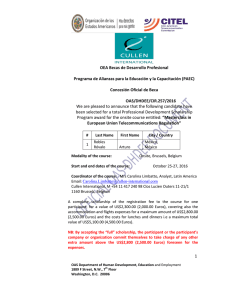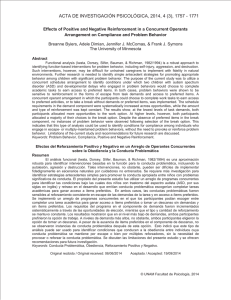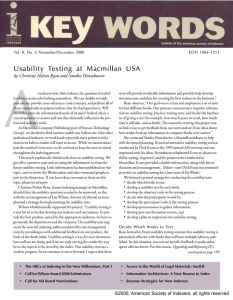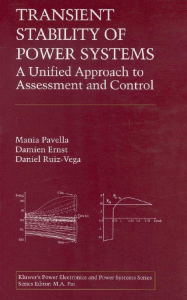Analyzing Behavioral and Cultural Selection Contingencies
Anuncio
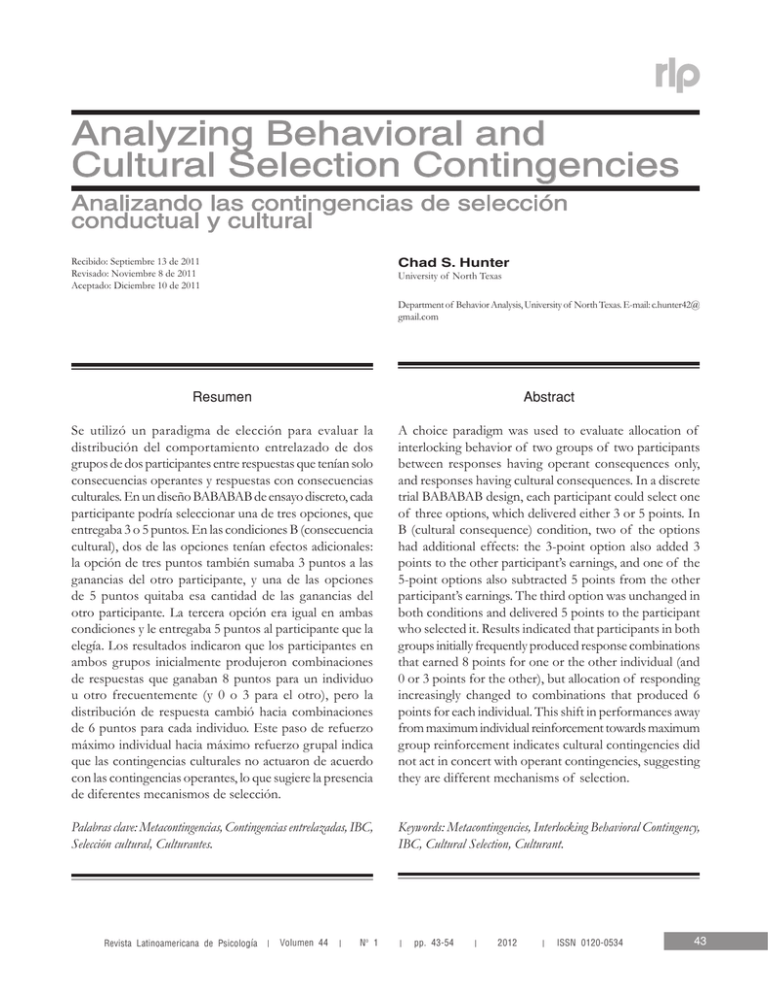
Analyzing Behavioral and Cultural Selection Contingencies Analyzing Behavioral and Cultural Selection Contingencies Analizando las contingencias de selección conductual y cultural Recibido: Septiembre 13 de 2011 Revisado: Noviembre 8 de 2011 Aceptado: Diciembre 10 de 2011 Chad S. Hunter University of North Texas Department of Behavior Analysis, University of North Texas. E-mail: c.hunter42@ gmail.com Resumen Abstract Se utilizó un paradigma de elección para evaluar la distribución del comportamiento entrelazado de dos grupos de dos participantes entre respuestas que tenían solo consecuencias operantes y respuestas con consecuencias culturales. En un diseño BABABAB de ensayo discreto, cada participante podría seleccionar una de tres opciones, que entregaba 3 o 5 puntos. En las condiciones B (consecuencia cultural), dos de las opciones tenían efectos adicionales: la opción de tres puntos también sumaba 3 puntos a las ganancias del otro participante, y una de las opciones de 5 puntos quitaba esa cantidad de las ganancias del otro participante. La tercera opción era igual en ambas condiciones y le entregaba 5 puntos al participante que la elegía. Los resultados indicaron que los participantes en ambos grupos inicialmente produjeron combinaciones de respuestas que ganaban 8 puntos para un individuo u otro frecuentemente (y 0 o 3 para el otro), pero la distribución de respuesta cambió hacia combinaciones de 6 puntos para cada individuo. Este paso de refuerzo máximo individual hacia máximo refuerzo grupal indica que las contingencias culturales no actuaron de acuerdo con las contingencias operantes, lo que sugiere la presencia de diferentes mecanismos de selección. A choice paradigm was used to evaluate allocation of interlocking behavior of two groups of two participants between responses having operant consequences only, and responses having cultural consequences. In a discrete trial BABABAB design, each participant could select one of three options, which delivered either 3 or 5 points. In B (cultural consequence) condition, two of the options had additional effects: the 3-point option also added 3 points to the other participant’s earnings, and one of the 5-point options also subtracted 5 points from the other participant’s earnings. The third option was unchanged in both conditions and delivered 5 points to the participant who selected it. Results indicated that participants in both groups initially frequently produced response combinations that earned 8 points for one or the other individual (and 0 or 3 points for the other), but allocation of responding increasingly changed to combinations that produced 6 points for each individual. This shift in performances away from maximum individual reinforcement towards maximum group reinforcement indicates cultural contingencies did not act in concert with operant contingencies, suggesting they are different mechanisms of selection. Palabras clave: Metacontingencias, Contingencias entrelazadas, IBC, Selección cultural, Culturantes. Keywords: Metacontingencies, Interlocking Behavioral Contingency, IBC, Cultural Selection, Culturant. Revista Latinoamericana de Psicología Volumen 44 No 1 pp. 43-54 2012 ISSN 0120-0534 43 Hunter Behavior of analytic research is concerned with the environment and behavior of single organisms. This is because behavior is something that individuals do, but groups do not. However, there are some situations in natural environment in which the behavior of an organism provides discriminative or consequential stimuli for the behavior of another organism (Skinner, 1953). Similarly, behavior of two individuals may affect the environment differently than if each behaved alone. In these scenarios, the behavior and environment of both individuals must be studied together. Previous experimentation manipulated contingencies between group members and contingencies acting upon the group as a whole. Studies which have researched contingencies between group members examined the function of one participant’s behavior on the behavior of another participant. Skinner (1962) trained pigeons to play ping-pong; pecks to the ball by one bird provided a discriminative stimulus for the opponent bird to peck the ball, and vice-versa. Performance established in isolation degraded in the presence of an opponent, possibly due to an increased delay to reinforcement caused by the opponent pecking the ball. Similarly, Boren (1966) trained pairs of monkeys to feed one another. Each subject pulled a lever that delivered a food pellet to the other subject in an adjacent chamber. Both subjects fed each other to satiation when forced to alternate responses; when the alternation requirement was removed, response rates were degraded until both subjects nearly starved to death, and the experiment was halted. In Skinner’s (1962) and Boren’s (1966) preparations, the behavior of dyad members created internal contingencies which disrupted the performance of both individuals. Studies which investigated group contingencies made contingent reinforcement upon aggregated behavior of group members. In these preparations, participants received either individual (e.g., Cohen & Lindsley, 1964; Skinner, 1962; Schmitt & Marwell, 1966) or communal (e.g., Azrin & Lindsley, 1956; Grott & Neuringer, 1974; Vichi, Andery, & Glenn, 2009; Wiggins, 1966) access to reinforces to complete a task which none of the participants could complete alone. These external contingencies were enough to maintain the interrelated behavior of group members in every study. 44 Revista Latinoamericana de Psicología Volumen 44 When multiple individuals behave in a common environment, external contingencies may select not just individual behaviors, but behaviors with contingencies that interlock (Glenn, 1988, 1991, 2004). Certain interlocking behavioral contingencies (IBCs) affect the environment differently than others, and they may recur. This selective recurrence of IBCs by their consequences is designated here as cultural selection. The effect on the environment produced by an IBC is an aggregate of the interlocking behavior of all participants, named the aggregate product. The contingency between occurrences of the IBC and resulting aggregate products has been called a metacontingency (Glenn, 2004). IBCs selected by a metacontingency will be called culturants. Metacontingencies describe the process by which lineages of culturants are formed and persist across time. The culturant resembles the operant since they are both units of behavior which have been selected by the environment. The two units differ in that operants are a phenomenon of individual organisms whereas culturants necessarily involve the behavior of more than one organism. Houmanfar and Rodrigues (2006) asserted that interlocking behavioral contingencies are subject to a lower level of selection than other cultural phenomena because they consist of operants. Others (e.g., Mattaini, 2004; Salzinger, 2004; Ulman, 2004) have questioned the need for an emergent level of selection to explain the recurrence of interlocking behavior. Skinner stated “no new [behavioral] processes” (1987) (p. 74) are needed to explain cultural selection. However, while IBCs do include operant behavior, the mechanism which chooses this operant behavior may not be the same mechanism that chooses the IBC as a whole (c.f., Glenn, 2004; Glenn & Malott, 2004c). Empirical support for metacontingencies is limited (e.g., Vichi, Andery, & Glenn, 2009). Although the studies discussed above were published before the concept of metacontingencies was introduced, they may be reinterpreted using terminology of cultural selection, as shown in Table 1. More recently, Vichi, Andery, and Glenn (2009) reported a metacontingency experiment that systematically replicated a procedure reported by Wiggins (1966), who did not use the current terminology. Participants invested tokens, completed a task, and received token reinforcers that were contingent not upon performance in the task, but on whether tokens were distributed equally or unequally (depending on the condition) in the previous trial. If the previous trial’s reward distribution matched the specification of the external No 1 pp. 43-54 2012 ISSN 0120-0534 Analyzing Behavioral and Cultural Selection Contingencies contingency (i.e., the metacontingency), the group’s total investment was doubled; if previous distribution did not match that specified by the external contingency, the group’s investment was halved. Participants were able to freely invest between 3 and 10 tokens each, and no differentiation was made regarding roles or unique access to resources for each participant. Conditions were changed when a stability criterion of ten successive successful trials was met. Results indicate that both groups distributed tokens equally or unequally to match the external contingency in effect. Stability was reached in fewer trials with each reversal of condition. These results appear to demonstrate differential selection of culturants. However, because target IBCs were also consequent with greater magnitude of reinforcement, it is possible that cultural selection did not occur, and operant contingencies were enough to maintain recurrence of the interlocking behavior. A more detailed analysis of the verbal behavior that occurred as participants completed the task and distributed reinforcers would provide more insight into the controlling contingencies. Method Participants Four adults participated in groups of two (one male and one female in each group) for this experiment. Participants were recruited by an ad in the university newspaper and were paid for their time. All participants gave informed consent, and this study was approved by the University of North Texas Institutional Review Board (# 08259). Participants were not screened to control prior histories before the experiment. Debriefing interviews revealed that the members of Dyad 1 did not know each other previously; the members of Dyad 2 were married to each other. Setting and Apparatus The experiment took place in a small lab room on campus with enough space for a 91 cm. by 91 cm. table and three chairs. The table featured a 61 cm. wide x 91 cm. tall opaque divider in the center, with a computer monitor and keyboard on either side of the divider. Participants sat across from each other, each facing a computer monitor and keyboard, with the divider preventing the participants from seeing each other. The experimenter sat to the side of the table in view of both participants in order to monitor the session. Confusion arises when operant contingencies and metacontingencies work in concert—essentially “selecting the same patterns of behavior.” The current experiment attempted to resolve this confusion by presenting multiple internal contingencies and multiple external contingencies as concurrent response options. Allocation of responding within and across each type of contingency indicated the relative control by each. In addition, the most advantageous option for the group was not the most advantageous option for each individual, precluding redundant operant and cultural accounts of selection. Both computer monitors and keyboards were connected to an Apple, Inc. © PowerBook © computer running Mac OS X © operating system version 10.4.11 (Apple, Inc., Cupertino, CA, www.apple.com). The software used in the experiment was custom designed and written using the Table 1 Application of Metacontingency Terminology to Previous Research Study Interlocking Behavioral Contingency Aggregate Product Cultural Consequence Azrin & Lindsley (1956) Both styli inserted into holes Styli in opposing holes within 0.04s of each other 1 Jellybean Skinner (1962a) Ball pecked back and forth Repeated volleys None Skinner (1962b) Keys pecked in both columns Correct set of keys pecked within 0.5s Individual access to grain Cohen & Lindsley (1964) Both plungers pulled Both plungers pulled within 0.5s or 0.1s 1 Penny each Schmitt & Marwell (1966) Both plungers pulled Both plungers pulled within 0.5s or 3.0s to 3.5s 1 Penny each Wiggins (1966) Rewards distributed Equal or unequal distributions Pennies Boren (1966) Forced: alt. lever presses Unforced: none Forced: both levers pressed Unforced: none Forced: food pellets Unforced: none Grott & Neuringer (1974) None Communal lever presses Communal access to water Vichi, Andery & Glenn (2009) Rewards distributed Equal or unequal distributions Tokens Revista Latinoamericana de Psicología Volumen 44 No 1 pp. 43-54 2012 ISSN 0120-0534 45 Hunter Python™ programming language, version 2.4.4 (Python Software Foundation, www.python.org). The displays on each computer monitor were identical during the entire experiment; that is, the same stimuli appeared on the screen of each participant. See Figure 1 for screenshots of the display used in the experiment. The central area of the screen was blank until a response occurred. When a colored crystal icon was selected, it appeared next to the column of the participant who had chosen it, and was visible to both participants. Once both participants had responded, the points delivered to each participant were displayed beneath the colored crystal icons that represented each choice. The two keyboards were modified using a label for each response option. Red, white, and green “crystal” (cube-shaped) figures were placed over the letters W, S, X and the word “Next” covered the T key on Participant A’s keyboard. The keys I, K, M, and B were similarly adapted on Participant B’s keyboard. All other keys on the keyboards were disabled; presses on those keys produced no effects. Procedures Each experiment took place during a single session on a weekday and lasted about one hour. Participants were instructed not to talk to each other once the experiment began. The experimenter read aloud these instructions, which were also displayed in the center of both monitors: “You and your partner are going on a mining expedition across the galaxy to replenish your Energy Crystals. There are 3 kinds of crystals, found in different amounts on each planet. Travel from planet to planet and choose which kind of crystal you would each like to mine. Each kind of crystal is worth the same amount.” Figure 1. Sample screenshots of the display used in the experiment. The top image shows a response made by one participant; the bottom image shows responses made by both participants. The numbers displayed under “Total Crystals” indicate the total points earned by that participant throughout the experiment, or the bank. Split into three sections, the left column of the screen of both monitors was labeled as the one of Participant A, and the right column as Participant B. In the left and right columns were three crystal-shaped icons, each one colored red, white, and green. Above these icons were the total points earned by Participant A on the left column, and the total earned by Participant B on the right column. As the value of these points changed, so did the color: black for no change, green when increasing, and red when decreasing. 46 Revista Latinoamericana de Psicología Volumen 44 This paragraph was cleared from the screen once the experiment began. Each participant started with 20 points, termed here the bank. When the trial started, the numbers in each participant’s bank changed from black (on the very first trial) or green (subsequent trials) to red in color, and started decreasing at a rate of 1 point every 2 seconds. At the same time, the red, white, and green crystal icons changed from an “inactive” button appearance to an “active” button appearance on the screen. Participants could then respond at any time, in either order, by pressing one of the three colored keys. If either participant’s bank reached zero, the session would end, although this did not happen. Once a response occurred, that participant’s red, white, and green buttons were inactivated (in both on-screen appearance and function), and his or her bank stopped decreasing and the numbers changed back to black in color. The stimulus No 1 pp. 43-54 2012 ISSN 0120-0534 Analyzing Behavioral and Cultural Selection Contingencies corresponding to that participant’s key press was then displayed in the center of the computer screen. This is shown in the top image of Figure 1. The bottom image of Figure 1 shows the display after both participants had responded. The points earned by each appeared below the colored crystal icons that represented each participant’s choice. At the same time, these points were added to each participant’s bank totals, and the numbers changed to a green color. Additionally, a button reading “Press Next to Continue” appeared on the screen, which when pressed on the keyboard, cleared all feedback and began the next trial. Participants could press this button at any time and in any order; only one response by one of the participants was needed. Participants were interviewed and debriefed regarding the details of the experiment. Experimental Design The experiment used a reversal design with discrete trials. Each experimental condition lasted 70 trials and was ordered BABABAB. Conditions A will be called independent because the consequences for the two participants’ responses were determined independently. B conditions will be called interdependent in that the contingencies for each of the two participants’ responses depended in part on the behavior of the other. Table 2 summarizes the points delivered for each response option in each condition. Table 2 Response Options and Resulting Points Condition B: interdependent consequences Participants A/B A: White (Share) A: Red (Neutral) A: 3 / B: 3 A: 5 / B: 0 A: Green (Steal) A: 5 / B: -5 B: White (Share) A: 3 / B: 3 6/6 8/3 8 / -2 B: Red (Neutral) A: 0 / B: 5 3/8 5/5 5/0 B: Green (Steal) A: -5 / B: 5 -2 / 8 0/5 0/0 Condition A: independent consequences Participants A/B A: White (Share) A: Red (Neutral) A: 3 / B: 0 A: 5 / B: 0 A: Green (Steal) A: 5 / B: 0 B: White (Share) A: 3 / B: 0 3/3 5/3 5/3 B: Red (Neutral) A: 0 / B: 5 3/5 5/5 5/5 B: Green (Steal) A: 0 / B: 5 3/5 5/5 5/5 Revista Latinoamericana de Psicología Volumen 44 Interdependent conditions During interdependent conditions, each of the three response options had two distinct effects. The first was to deliver points to the selecting participant’s bank. The second effect was to add or remove points from the other participant’s bank. The number of points added or removed for each response was not displayed; only the calculated point totals were shown on the screen. The response option with the simplest effect was the red icon, designated by the experimenter as neutral (because it was neutral with respect to points for the other player). Five points were gained when this option was chosen. The green (steal) option also delivered 5 points when chosen, but subtracted these points from the other participant’s Bank. The white (share) option provided 3 points when chosen, and also provided 3 points to the other participant. The points contingent on both players’ choices were added or subtracted together at each round. For example, if both participants chose white (share), they both earned 6 points—three points generated by themselves, and three points generated by the other’s response. If, instead, one of them chose red (neutral) and the other white (share), then the participant choosing red earned 8 points (5 + 3) while the participant who chose white earned only 3 points (3 + 0). In this way, choosing white (share) could result in -2, 3, or 6 points; choosing red (neutral) could result in 0, 5, or 8 points; and choosing green (steal) could result in 0, 5, or 8 points. It is important to see that while an individual participant could receive maximum (8) points in a trial by selecting red (neutral) or green (steal), both participants could not earn 8 points by selecting red or green in the same trial. In order for both participants to maximize reinforcement, they both must have chosen white (share), but they only earned 6 points each for doing so. In addition, the first participant to select white (share) in a trial risked earning fewer points if the other participant then selected red (neutral) or green (steal). Thus, for a most coordinated response to occur, the first participant to respond risked receiving less reinforcement, while the second participant to respond could receive greater reinforcement with no risk. Independent Conditions During independent conditions, the contingencies for each participant were separate. Each of the three response options had a single effect, which was to add points to No 1 pp. 43-54 2012 ISSN 0120-0534 47 Hunter the selecting participant’s bank. The white (steal) button provided 3 points when pressed. The green (steal) button provided 5 points when pressed. The red (neutral) button provided 5 points when pressed. None of the three response options affected the points earned by the other participant. Note that during the independent conditions the consequences for the red (neutral) button and the green (steal) button were identical, whereas the consequence for the white (share) button was always less advantageous (i.e., produced less reinforcement). This condition was designed as a control to determine if patterns of responding would persist in the absence of cultural contingencies. The red (neutral) button produced the same effect in both conditions. Results Figures 2 to 4 present the data for Dyad 1. Figure 2 shows the cumulative responses of each participant. During the first four phases, participants selected primarily red and green (neutral and steal), regardless of condition. However, early in Phase V (an interdependent condition), responding to these options paused, and both participants switched to white (share) exclusively for the remaining 65 trials. Upon entering the next independent condition (Phase VI), both participants quickly switched to the red (neutral) key, which they pressed exclusively until the interdependent condition was again instated, whereupon they returned to selecting the white icon that resulted in sharing gains. Thus, in the last three phases, participants in Dyad 1 maximized gains by adapting to the externally imposed conditions. When both participants select the same option in a single trial, or when participants emit the same response at the same time, this homogeneity of responding has been referred to as coordination (e.g., Azrin & Lindsley, 1956; Schmitt & Marwell, 1968; Skinner, 1962; Vichi, Andery & Glenn, 2009; Wiggins, 1966). This homogeneity of responses can be described as a dyadic response and treated as a unit (e.g., Azrin & Lindsley, 1956; Schmitt & Marwell, 1968; Skinner, 1962; Vichi, et al, 2009; Wiggins, 1966). Unlike an IBC, which is defined by its function, a dyadic response is classified according to topographical characteristics. Also unlike an IBC, the behaviors of each participant might not form interlocking contingencies. 48 Revista Latinoamericana de Psicología Volumen 44 Figure 2. Cumulative individual responding, Dyad 1. Reponses by Participant A are shown in the top half of the chart; responses by Participant B are shown in the bottom half. Interdependent conditions (Phases I, III, V, & VII) are denoted by a grey background. Figure 3 shows dyadic responses of Dyad 1 during the course of the experiment. The first type of dyadic response, dyadic neutral (both pressed red keys), occurred at relative steady rates during the first stage and all independent phases, but almost never occurred during subsequent interdependent phases. The dyadic steal (both pressed green) response showed a positively accelerating change in rate until Phase V, wherein rate of response dropped to zero, and remained low until the end of the session, regardless of which condition was active. In contrast, the dyadic share response (both pressed white) occurred at very low rates until interdependent conditions were present in stage V. A clear reversal then occurs between conditions as rates of dyadic share dropped to zero in stage VI and accelerated again in stage VII. In summary, interdependent contingencies eventually supported selection of dyadic share, whereas independent contingencies eventually supported selection of dyadic neutral and it seems the dyadic steal was unselected and abandoned. Thus, participants in Dyad 1 were able to coordinate their behavior both individually and as a dyad to meet the externally imposed conditions. No 1 pp. 43-54 2012 ISSN 0120-0534 Analyzing Behavioral and Cultural Selection Contingencies Figure 3. Cumulative dyadic responding, Dyad 1. Interdependent conditions (Phases I, III, V, & VII) are denoted by a grey background. Given the little difference between individual and dyadic performances of Dyad 1, the question arises as to whether the data represent the result of contingencies governing individual performances, or contingencies governing the dyad’s performance as a whole. In other words, is Dyad 1 performing as a unit, or as two independently performing individuals? Figure 4 attempts to answer this question by cumulating the trials in which an individual participant maximized reinforcement (e.g., earned 8 points) against the trials in which the dyad had maximized reinforcement (e.g., earned 6 points each). Dyadic maximization resulted from two white (share) responses in a trial while individual maximization resulted of a share response from one participant and either a red (neutral) or green (steal) response from the other participant in a single trial. No data are shown during independent phases because the dyad is not able to maximize reinforcement in these conditions. Figure 4 shows that in the first two interdependent conditions (Stages I and III), the rate of maximization responses was higher for individual participants than for the dyad. This is to be expected because more points are available for individual maximization (8 points) than for dyadic maximization (6 points). However, in the last two interdependent conditions, the rate of dyadic maximization responses accelerated well beyond that of the individuals. Overall, this indicates that the contingencies governing maximizing reinforcement for the group were more powerful than the contingencies governing maximizing reinforcement for any single participant in Dyad 1. Revista Latinoamericana de Psicología Volumen 44 No 1 Figure 4. Responding that maximized points, Dyad 1. Interdependent conditions (Phases I, III, V, & VII) are denoted by a grey background. No data are shown during independent conditions (Phases II, IV, & VI) because participants could not maximize points in these conditions. The data are not clear enough for Dyad 2, shown in Figures 5 to 7. As seen in Figure 5, Participant B showed similar rates of responding for all three selections, regardless of condition. Participant A, however, seemed to show break-and-run patterns of selecting a single key for many trials before switching to a different key. Consequently, for Participant A, pressing green (steal) and red (neutral) occurred often for most of the experiment until stages V and VI, when pressing white (share) began to increase significantly. Interestingly, both participants selected white (share) in extended bursts during independent stages IV and VI despite the lower reinforcement it provided in comparison to red (neutral) or green (steal) in these conditions. It is not clear whether this pattern was due to insensitivity to condition changes, random sampling of alternatives, or dependent contingencies between participants. Figure 6 shows the cumulative dyadic responding. Dyadic steal was the only response option that was clearly responsive to condition changes, when the rate of response was positive during interdependent stages V and VII but dropped to zero in Phase VI. However, frequencies of dyadic neutral and dyadic share eventually adapted to match the external conditions in the last three stages. This points to the dyad as a unit was responsive to the condition changes, but as individuals, the participants were not. pp. 43-54 2012 ISSN 0120-0534 49 Hunter conditions. Participant B, however, maximized reinforcement often during the first and last stages (I and VII) but less frequently during the middle of the session (stages III and V). Dyadic maximization response combinations increased throughout the session, occurring more frequently during the first and last stages (I and VII) and less frequently during the middle stages (III and V). Overall, this points to the independent conditions disrupted the performance of Participant A and the Dyad during subsequent interdependent conditions, although rates of maximization responses did recover by the end of the experiment. Unlike Dyad 1, Dyad 2 did not “switch” from individual to dyadic maximization responding; rather, Dyad 2 increased dyadic maximization responses while continuing to frequently maximize reinforcement as individuals. Thus, it is unclear the extent to which Dyad 2’s performance was governed more by operant or cultural contingencies, because both appear to have exerted influence during interdependent conditions. Figure 5. Cumulative responding, Dyad 2. Reponses by Participant A are shown in the top half of the chart; responses by Participant B are shown in the bottom half. Interdependent conditions (Phases I, III, V, & VII) are denoted by a grey background. Figure 7. Responding that maximized points, Dyad 2. Interdependent conditions (Phases I, III, V, & VII) are denoted by a grey background. No data are shown during independent conditions (Phases II, IV, & VI) because participants could not maximize points in these conditions. Figure 6. Cumulative dyadic responding, Dyad 2. Interdependent conditions (Phases I, III, V, & VII) are denoted by a grey background. Figure 7 shows responses that maximize reinforcement for the individual against responses that maximize reinforcement for the dyad. As described above, only the interdependent conditions may be compared. Participant A maximized individual reinforcement frequently during all of these 50 Revista Latinoamericana de Psicología Volumen 44 The points earned or lost in each trial by each participant from experiments 1 and 2 are shown in Figures 8 and 9. During independent conditions, when consequences did not interact, participants in Dyad 1 earned maximum reinforcement available (5 points) in 185 out of 210 trials (88%). Participants in Dyad 2, however, quite often did not earn maximum reinforcement. Participant A maximized only 62.9% of trials in stage II, and Participant B maximized in 52.9% of trials in stage IV; together, they only maximized reinforcement in 151 of 210 trials, or 71.9%. This indicates that Dyad 1 was more responsive to independent conditions than Dyad 2. During interdependent conditions, Dyad 1 No 1 pp. 43-54 2012 ISSN 0120-0534 Analyzing Behavioral and Cultural Selection Contingencies “switched” from occasional individual maximization (8 points for 1 participant) to mostly dyadic maximization (6 points for both participants) as the experiment progressed. Dyad 2, on the other hand, gradually increased the number of dyadic maximization responses while continuing to frequently maximize at the individual level across all interdependent conditions. responded first in the majority of trials until the end of the experiment. Variability in leader-follower trends occurred more during interdependent conditions than independent conditions for Dyad 1. Dyad 2 differed in that clear leader-follower relations did not develop. However, rates of leader responses were higher for Participant B during independent conditions, while rates of leader responses where higher for Participant A during interdependent conditions. This difference became more pronounced as the session progressed. Additionally, smooth scalloping curves of leader responses across conditions points to orderly shifts occurred in leader-follower relations between participants of Dyad 2. Figure 8. Points earned each trial, Dyad 1. Interdependent conditions (Phases I, III, V, & VII) are denoted by a grey background. Figure 10. Cumulative trials wherein Participant B responded first. Interdependent conditions (Phases I, III, V, & VII) are denoted by a grey background. Discussion Figure 9. Points earned each trial, Dyad 2. Interdependent conditions (Phases I, III, V, & VII) are denoted by a grey background. “Leader-follower relations” (e.g., Azrin & Lindsley, 1956; Cohen & Lindsley, 1964; Skinner, 1966), wherein one participant reliably responds before the other, they are shown in Figure 10 for both dyads. Only data for Participant B in each dyad are shown due to the fact that this is the reciprocal of the data for Participant A. In Dyad 1, after initial exploration during Phase 1, the first response was emitted by Participant B in most trials. After Trial 174, the leader-follower relation reversed, and Participant A Revista Latinoamericana de Psicología Volumen 44 No 1 The results indicate that the concurrent choice preparation used in this experiment was effective for evaluating the effects of individual and cultural contingencies. Initially, participants most frequently selected the options that produced greater reinforcement in individual contingencies (or higher probability of reinforcement), such as red (neutral) and green (steal). As the sessions progressed, however, participants increasingly selected white (share), which produced relatively less reinforcement at the individual level. However, this option maximized reinforcement at the dyadic level. Allocation of responding shifted from the most reinforcing option for an individual, to the most reinforcing option for both individuals. This shift occurred despite producing less reinforcement for each response, more risk for the leader, and less than maximum reinforcement for the follower. This contrasts with previous experimental procedures (e.g., Azrin & Lindsley, 1956; pp. 43-54 2012 ISSN 0120-0534 51 Hunter Cohen & Lindsley, 1964; Skinner, 1962; Wiggins, 1966; Vichi, Andery & Glenn, 2009) wherein group responses produced reinforcement, but individual responses were not directly reinforced. In those experiments, operant and cultural contingencies exerted redundant selection effects. In the current experiment, operant and cultural contingencies were not clearly redundant, making it easier to distinguish selection by each. Limiting the forms of interaction allowed better control and analysis of the structure of the IBC than in previous research (e.g., Vichi et al, 2009). Dependent contingencies may have accounted for some of the unexpected patterns of behavior emitted by Dyad 2. Both participants selected the white (share) option across many trials during independent conditions, despite earning fewer points for doing so. Participant A, for instance, pressed the white key exclusively for the first half of Phase VI. This pattern may have been reinforced by the actions of the other participant rather than point delivery. Modeling the desired response would be reinforced once the other participant pressed the white (share) button. Unfortunately, when this coordinated response occurred, it produced less reinforcement during independent conditions than the alternatives, and it was selected against by the current condition. This may explain why it took longer for Dyad 2 than Dyad 1 to coordinate responding and maximize reinforcement as a group. Alternative explanations may account for the observed shift in responding from individual to dyadic maximization options that do not require a cultural mechanism of selection. For instance, participants may have had a prior reinforcement history that supported equal distribution of rewards, despite the decreased reinforcement for doing so in this experiment. This hypothesis could be tested by using subjects whose histories can be controlled, such as pigeons, rats, or monkeys. Additionally, despite efforts to limit possible interactions between participants, verbal behavior may have been emitted which exerted discriminative or reinforcing control over responding. Extraneous control by these dependent contingencies could be mitigated in future experiments by isolating participants from each other (e.g., using different rooms). Of interest is the degree to which the results indicate cultural selection by metacontingencies. In all conditions 52 Revista Latinoamericana de Psicología Volumen 44 of this experiment, the contingency between the selections of both participants and the resulting aggregate product of colored stimuli combinations constituted a relation between the Interlocking Behavioral Contingency (IBC) and the aggregate product. Cultural consequences of different magnitudes were delivered contingently upon occurrences of different IBC-aggregate product relations. However, the effect of a particular IBC on the cultural consequence differed in A and B conditions. During independent (A) conditions, cultural consequences could not be altered by the other participant’s behavior. During interdependent (B) conditions, cultural consequences could be altered by the other participant’s behavior, or not, depending on the IBC that occurred. Thus, all performances were interlocking behavioral contingencies, and all generated aggregate products, but a contingency between IBCs having particular products and cultural consequences existed only in the interdependent conditions. Selection by metacontingencies was apparent in this experiment as cultural consequences resulted in dyadic IBCs when in effect. Additionally, development of specific leaderfollower relations in each dyad indicates specific IBCs were selected. For Dyad 2, different conditions appeared to affect different leader-follower IBCs. Alternating the activation and deactivation of the cultural consequence resulted in additional effects. Patterns of responding that developed during interdependent conditions sometimes continued during independent conditions despite the lack of external cultural contingencies. Three out of four participants ceased to select green (steal) as often as red (self) in stage VI compared to stage IV, even though each option produced the same amount of reinforcement in these conditions. This unexpected pattern of responding likely would not have developed if participants were insensitive to the contingencies interlocking their responses in previous conditions. Sensitivity to controlling variables was confirmed in verbal reports after the experiment, shown in Figure 10. Three out of four participants (but not Participant B in Dyad 2) reported observing the points delivered to the other participant, and could tact the general effects of each response option on the other participant’s earnings. All participants reported comparing the total points in each participant’s bank. Only one participant (Participant A in Dyad 1) came close to tacting the manipulation of the independent variable, saying, “Sometimes we would get six points for [both] choosing white, and sometimes we didn’t.” No 1 pp. 43-54 2012 ISSN 0120-0534 Analyzing Behavioral and Cultural Selection Contingencies future experiments may reduce between-group differences in response patterns. References Figure 11. Verbal reports of participants in post-experimental debriefing. Black bars indicate the number of participants that reported each item; white bars indicate the number of participants that did not report each item. Overall, there was a large amount of between-group variability in responding. The most orderly patterns of responding were generated by Dyad 1, whose members did not have a prior history of interaction with each other. Dyad 2 exhibited less orderly behavior, and the members of this dyad already had extensive histories of interaction with each other. Limiting interactions between participants in Revista Latinoamericana de Psicología Volumen 44 No 1 Azrin, N. H. & Lindsley, O. R. (1956). The reinforcement of cooperation between children. Journal of Abnormal and Social Psychology, 52, 100-102. Boren, J. J. (1966). An experimental social relation between two monkeys. Journal of the Experimental Analysis of Behavior, 11, 691-700. Cohen, D. J. & Lindsley, O. R. (1964). Catalysis of controlled leadership in cooperation by human stimulation. Journal of Child Psychology and Psychiatry, 5, 119-137. Glenn, S. S. (1986). Metacontingencies in Walden Two. Behavior Analysis and Social Action, 5, 2-8. Glenn, S. S. (1988). Contingencies and metacontingencies: Toward a synthesis of behavior analysis and cultural materialism. The Behavior Analyst, 11, 161-179. Glenn, S. S. (1991). Contingencies and metacontingencies: Relations among behavioral, cultural, and biological evolution. In P. A. Lamal. (Ed.), Behavioral analysis of societies and cultural practices (pp. 39-73). Reno, NV: Hemisphere Press. Glenn, S. S. (2004). Individual behavior, culture, and social change. The Behavior Analyst, 27, 133-151. Glenn, S. S. & Malott, M. E. (2004). Complexity and selection: Implications for organizational change. Behavior and Social Issues, 13, 89-106. Glenn, S. S. & Malott, M. E. (2004b). On conceptual challenges: Reply to Hayes & Houmanfar. Behavior and Social Issues, 13, 112-115. Glenn, S. S. & Malott, M. E. (2004c). Behavioral and cultural classifications: Reply to Mattaini. Behavior and Social Issues, 13, 131-133. Grott, R. & Neuringer, A. (1974). Group behavior of rats under schedules of reinforcement. Journal of the Experimental Analysis of Behavior, 22, 311-321. Hayes, L. J. & Houmanfar, R. (2004). Units and measures: A response to Glenn & Malott. Behavior and Social Issues, 13, 107-111. Houmanfar, R. & Rodrigues, J. (2006). The metacontingency and the behavioral contingency: Points of contact and departure. Behavior and Social Issues, 15, 13-30. pp. 43-54 2012 ISSN 0120-0534 53 Hunter Lindsley, O. R. (1966). Experimental analysis of cooperation and competition. In Tom Verhave (Ed.), The experimental analysis of behavior (pp. 470-501). New York: Appleton-Century-Crofts. Malott, M. & Glenn, S. S. (2006). Targets of intervention in cultural and behavioral change. Behavior and Social Issues, 15, 31-56. Mattaini, M. (2004). Systems, metacontingencies, and cultural analysis: Are we there yet? Behavior and Social Issues, 13, 124-130. Salzinger, K. (2004). Life is complicated; analysis should be simple. Behavior and Social Issues, 13, 140-142. Schmitt, D.R. (1984). Interpersonal relations: Cooperation and competition. Journal of the Experimental Analysis of Behavior, 42, 377-383. Schmitt, D. R. & Marwell, G. (1968). Stimulus control in the experimental study of cooperation. Journal of the Experimental Analysis of Behavior, 11, 571-574. 54 Revista Latinoamericana de Psicología Volumen 44 Skinner, B.F. (1962). Two synthetic social relations. Journal of the Experimental Analysis of Behavior, 5, 531-533. Skinner, B. F. (1981). Selection by consequences. Science, 213, 501-4. Skinner, B. F. (1987). Upon further reflection. Englewood Cliffs, NJ: Prentice-Hall. Ulman, J. D. (2004). Macrocontingencies: Comments on Glenn and Malott’s “Complexity and Selection.” Behavior and Social Issues, 13, 147-151. Vichi, C., Andery, M., & Glenn, S. S., (2009). A metacontingency experiment: The effects of contingent consequences on patterns of interlocking contingencies of reinforcement. Behavior and Social Issues, 18, 41-57. Wiggins, J. A. (1966). Status differentiation, external consequences, and alternative reward distributions. Sociometry, 29, 89-103. No 1 pp. 43-54 2012 ISSN 0120-0534


